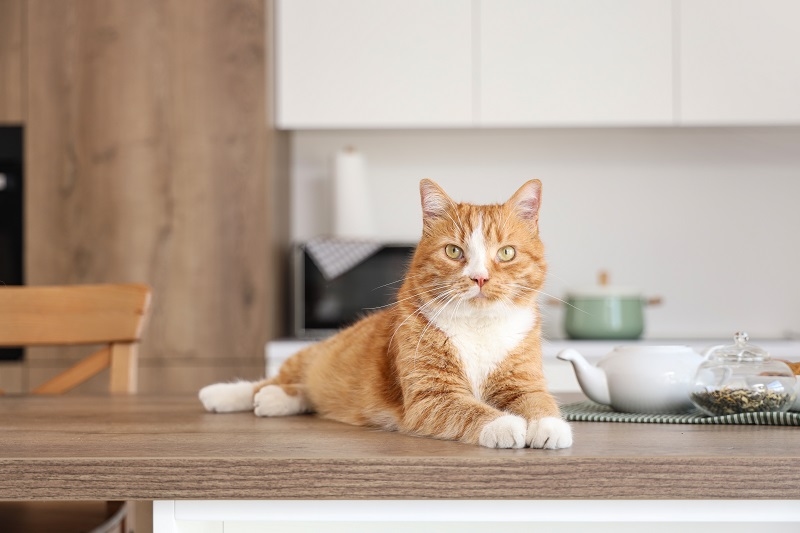
How to Make Your Kitchen Counter Cat-Proof Effectively
Keeping cats off their counters can be a tricky business. Cats can jump, climb, and squeeze into spaces almost anywhere they want to, including your kitchen countertop. For many pet parents, the countertop is a sacred space for cooking, food preparation, and hygiene development to keep our food safe. For cats, it's a little different; it might be a new area to explore, a place where food smells linger, or it might just be the highest point in the room. Learning how to cat-proof kitchen surfaces and countertops is essential because it can keep your kitchen cleaner and your cat safe.
Whether you want to deter cats from the countertop by keeping food on a table, avoiding accidents, or enjoying peace of mind, completely safe strategies exist. In this article, you will learn everything from why cats jump to how to use creative counter space deterrents and long-term cat training ideas.
Why Cats Love Kitchen Counters
Knowing what that behavior is is helpful before you can prevent it. Cats do not get onto your counters to irritate you! Here are their motivations based on instinct:
- Height: Cats feel safe from threats when high up so that they can observe their environment.
- Food: Kitchen counters are often associated with food.
- Attention: Cats notice when you react in a big way to their countertop antics.
- Curiosity: The kitchen has many sounds and things that might be distant from the evidence of food-leaking sinks and crinkly wrappers, to name a few.
Once you know the motivations, you can better avoid cats on kitchen counters, minus the frustration.
Why Cat-Proofing Matters
It's not only about cleanliness. There are risks when letting cats on counters:
- Health Risks: Cats walk through litter boxes and then jump onto food-preparation areas.
- Injury Risks: Sharp knives, hot stovetops, and glassware can injure curious cats.
- Encouragement of Bad Behavior: The more your cat associates counters with reward (food specifically), the harder it will be to break it.
That's why cat-proof kitchen counters are necessary for a safe and healthy home.
Step 1: Remove Temptations
The easiest way to cat-proof kitchen countertops is to remove the things that brought them there in the first place.
- No food left out: Always put leftovers and ingredients in sealed containers.
- Wipe surfaces: Get rid of crumbs and lingering smells.
- Close off access: Cover sinks, trash bins, and dish racks that interest cats.
A clean counter is not inviting and will make it easier to keep cats off of countertops naturally.
Step 2: Provide Alternatives
Cats climb for enrichment. If you want to be successful in keeping your cat off the kitchen counter, then provide alternatives:
- Cat Trees and Towers: Add them near windows or, even better, near a great view.
- Wall-mounted shelves: Provide some vertical climbing options!
- Window perches: Redirect their attention with a good sunny sitting spot.
Once cats have their own "high places," they'll be less likely to use your counter as their jungle gym.
Step 3: Use Gentle Deterrents
Sometimes cats require a bit more of a nudge to discourage inappropriate behavior. Safe cat deterrents for countertops are:
- Aluminum Foil Sheets: Most cats dislike the crinkly nature of foil.
- Double-Sided Tape: Sticky sensations can discourage climbing.
- Plastic Carpet Runners (nubs up): Cats will avoid nubs, get frustrated, and not return for more.
- Scent Deters: Citrus is an effective distraction. Using citrus peels or citrus-scented sprays may also help deter cats, as cats dislike this odor.
A few simple tricks can help keep curious cats off kitchen counters without harming them.
Step 4: Train with Positive Reinforcement
Disciplining cats is not particularly effective; often, it has an adverse effect. Instead, focus on training your cat with a reward for good behavior:
- Clicker Training: Reward your cat when it makes the choice to jump up on its cat tree instead of the counter.
- Placement of Treats: Store treats with or on a place your cat can climb, like a cat tower.
- Redirecting: When your cat jumps up onto the counter, softly put the cat on its cat tree to reinforce the positive behavior.
Over time, you'll be repeatedly redirecting your cat enough that it will learn that any effort to jump up and explore the counter is not worth the reward.
Step 5: Block Access When Needed
Sometimes, physical barriers are the most straightforward solution:
- Close Kitchen Doors: Limit access when you're not around.
- Baby Gates: Tall gates can help in open-plan homes.
- Cover Surfaces: Place cutting boards or trays when cooking to discourage access.
Though not always foolproof, these steps add extra layers of protection for cat-proof countertops.
Specific Tips to Prevent Cats from Getting on Kitchen Counters
Here are some other cat-off-kitchen-counter strategies that can be effective:
- Use Motion Sensitivity Products: There are a variety of devices that spray harmless bursts of air when it detects movement.
- Use Stovetop Safety Covers: These cover the burners to prevent burns when not in use.
- Feed Strategically: Feed your cat before preparing the food. They will be less inclined to bother you when you are in the kitchen if they have been fed.
- Play Prior to Cooking: Play with toys or use toys to tire your cat to redirect that energy.

Creating a Cat-Friendly Kitchen
Cat-proofing doesn't mean making your kitchen hostile to your feline-it means balancing boundaries. Try to:
- Place a cat tree near the kitchen so they can still watch you cook.
- Allow safe exploration of drawers or cabinets that don't contain hazards.
- Offer enrichment toys to reduce boredom-driven climbing.
This approach shows respect for their instincts while maintaining hygiene and safety.
Common Mistakes to Avoid
When learning how to cat-proof countertops, avoid these pitfalls:
- Yelling or Punishing: Creates fear, not learning.
- Using Unsafe Deterrents: Never use substances that could harm your cat.
- Inconsistency: If you sometimes allow counter access, your cat will keep testing.
Consistency and patience are the keys to success.
Comparing Cat-Proofing Methods
| Method | Effectiveness | Safety | Effort Required |
| Aluminum Foil | High | Safe | Low |
| Double-Sided Tape | High | Safe | Medium |
| Cat Trees | High | Very Safe | Medium |
| Motion-Activated Devices | Very High | Safe | High |
| Closing Doors | High | Safe | Low |
Depending on your lifestyle, this comparison helps you choose the proper cat deterrent for countertops.
Long-Term Strategies for Success
Training cats takes time. Here's how to make results last:
- Stay Consistent: Reinforce rules daily.
- Update Environment: Adjust perches and climbing spaces as your cat grows.
- Balance Rules with Rewards: Cats obey more when positive outcomes are clear.
A combination of environmental changes, training, and deterrents ensures your efforts to cat-proof kitchen counters stick for the long haul.
Safety First: Protecting Your Cat and Kitchen
While preventing cats from getting on kitchen counters is about hygiene and discipline, it's also about keeping your pet safe. Remember:
- Always unplug appliances when not in use.
- Store knives and sharp tools immediately.
- Secure trash bins and recycling.
- Never leave toxic foods (onions, chocolate, grapes) within reach.
Safety precautions secure your kitchen, even if your cat occasionally makes it onto the counter.
Final Thoughts
Successfully cat-proofing your kitchen counter requires time and effort, but it is worth it. You can create a space that allows your cat to be happy and healthy and does not take over your kitchen. If you combine practical deterrents, positive training, and safe alternatives, you will learn to find a home placement for your cat that is happy and free of kitchen counters.
From physical cat deterrents on countertops to more brilliant redirection ideas, every step continues the interplay between your pet's instinct and what is best for your home. Remember that you are not punishing your cat; instead, you are helping them make better choices and looking out for safety, cleanliness, and good pet ownership.
With love and persistence, your cat will always find joy in their perches, trees, and windows, while you enjoy clean and stress-free counters.
